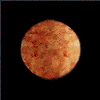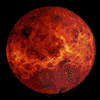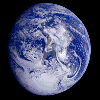Welcome to the Planets!
As you know, there are are eight planets and five dwarf planets in our solar system.

The Inner Planets (Terrestial)
The inner planets are called terrestial planets. The word terrestial comes from the Latin word, "terra," which means earth or earth-like. These planets are dense, solid, rocky and have a metal core. These are the first four planets closet to sun: Mercury, Venus, Earth, and Mars.
Mercury is the first planet. It is also the smallest planet in our solar system. Because it is so close to the sun it is very hot. It is also the fastest planet orbiting the sun, taking just over 58 days days. It rotates on its axis once every 88 earth days.
Venus is next. It is the closest planet to earth and about the same size. It is extremely hot and has constant thunderstorms. It's surface is covered in lava from volcanoes. It rotates on its axis very slowly (and in the opposite direction of all the other planets. One day on Venus is equal to 243 days on Earth!
Earth is an ocean planet, the third from the sun. It has lots of water and is the only planet that we know of that has life on it! It is the densest planet. It only has one moon. It's orbit around the sun is elliptical in shape. This and its tilt on it's axis cause the seasons.
Mars is the fourth planet from the sun. It is extremely cold. It also has lots of craters. Scientists think these crater were formed when meteorites hit it. Mars also has tallest mountains and deep valleys.
The Asteroid Belt comes next. This is where the dwarf planet, Ceres is located.
The Outer Planets (Jovian)
Outside the Asteroid Belt are the outer planets. These outer planets are called the "Jovian planets", or giant gas planets. They are not solid. They are Jupiter, Saturn, Uranus, and Neptune. Beyond Neptune is Pluto, a dwarf planet. Pluto's orbit sometimes crosses Neptune's orbit, then it is the eigth planet.
Jupiter is so large that all the other planets could fit inside of it. It is surrounded by clouds that constantly change color. The largest swirling area of gas is called the "Great Red Spot." It has 49 named moons and maybe as many as 63!
Saturn is called the ringed planet because of the hundreds of beautiful rings around it. It is believed that the rings are made out of ice and dust. Saturn spins really fast on its axis which makes it flatter on the top and bottom.
Uranus is tilted on its axis so much that it rotates sideways. It gets its blue-green color from the methane gas in its atmosphere. It is very cold and has 27 moons.
Neptune is the farthest planet from the sun and is very cold. It is blue-green like Uranus. It also has four rings two are thick and two are thin. It has very strong winds that blow over 1000 miles an hour!
Pluto and other Dwarf planets (Ceres, Eris, Haumea, Makemake). Pluto was thought to be the ninth planet until 2006 when it was reclassified as a dwarf planet. Pluto has an unusual orbit so sometimes it is closer to the sun than Neptune. Dwarf planet must: 1) orbit the sun, 2) be almost round in shape, 3) have other celestial things close to their orbit, and 4) not be a satellite.
Now, let's review what we learned and take the...
Planets Quiz:
Which planet orbits the sun the fastest?
A. Mercury
B. Mars
C. Neptune
D. Pluto
Which planets are the Jovian, giant gas planets?
A. Jupiter, Saturn, Uranus, Neptune, and Pluto
B. Mercury, Venus, Earth, and Mars
C. Pluto, Ceres, Eris, Hameau, and Makemake
D. Jupiter, Saturn, Uranus, and Neptune
What is the name for the inner planets?
A. Solid Planets
B. Rock Planets
C. Small planets
D. Terrestial Planets
Which planet is so large that all the other planets can fit inside it?
A. Saturn
B. Uranus
C. Pluto
D. Jupiter
Now, that you've had an introduction to our solar system and it's eight planets and of course, Pluto (a dwarf planet) it's time to blast off to your first mission...the "Planets WebQuest" so click on the link below:
Once you have completed the Planets WebQuest, don't space out, remember to return here to evaluate this mission and continue exploring the wonders of space.
Thanks for evaluating this web! Now rocket into the Stars!














